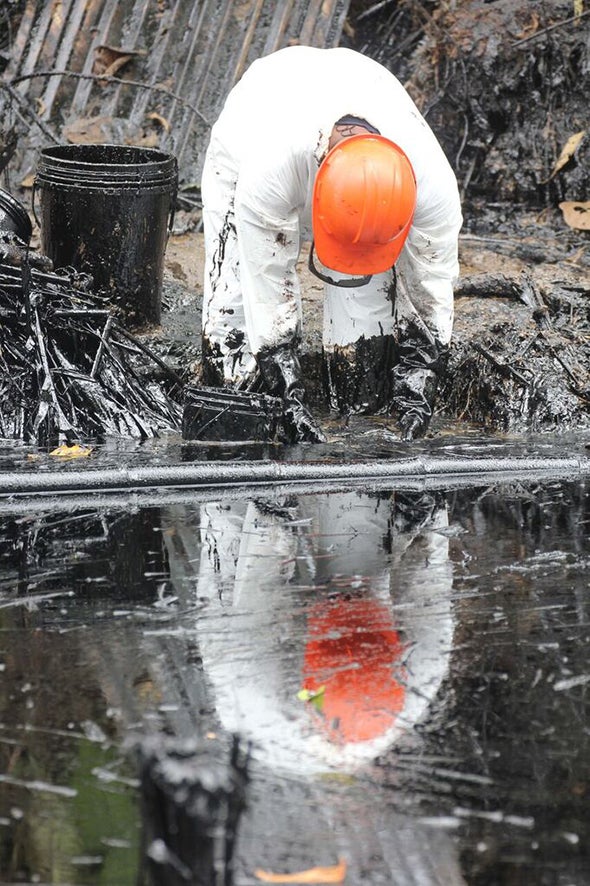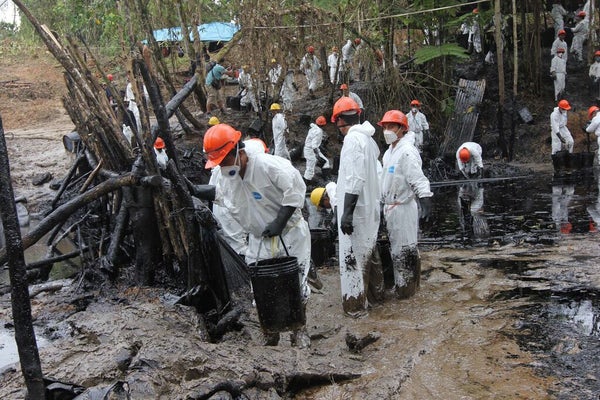The executives at Petróleos del Perú (PETROPERÚ) have had better days. The Interethnic Association for the Development of the Peruvian Rainforest, representing the local indigenous peoples, has organized protests and set up a picket outside the Lima headquarters of the state enterprise they say is responsible for leaks that released 3,000 barrels of oil (about 477,000 liters) in several rivers in the Peruvian Amazon.
Representatives of indigenous communities attributed the two accidents that occurred on January 25 and February 4 to a lack of maintenance of the company’s NorPeruano Pipeline. Scientific American consulted PETROPERÚ about it, but received no response. The crude, spilled in the Loreto Department in the northeastern part of the country, has contaminated at least 30 kilometers of the Chiriaco River and has spread into Marañon River, one of the main tributaries that feed the Amazon drainage area.
The area has large blocks of intact tropical forest and is considered one of the most biodiverse throughout the region, but scientists agree that so far it is impossible to calculate the spill’s real impact. “The Peruvian Amazon is extremely complex and diverse, but it is a part of the world from which we do not know much about,” says Clinton Jenkins, conservation biologist at the Institute of Ecological Research, in São Paulo, Brazil. “Knowing the biological impacts is difficult because we have very little information of what is there to begin with.”
On supporting science journalism
If you're enjoying this article, consider supporting our award-winning journalism by subscribing. By purchasing a subscription you are helping to ensure the future of impactful stories about the discoveries and ideas shaping our world today.
This is not the first time the Amazonian jungle of Peru has been threatened by the exploitation of hydrocarbons—and probably not be the last. Since 2011 there have been at least 20 emergencies due to faults in NorPeruano pipelines. This disaster is the latest example of a string of accidents that have black-stained the Amazon and occurs within a year of the release of more than 2,300 barrels of oil, also in Loreto. “It is a systemic problem,” Jenkins says. “These spills occur regularly and the impact will not easily disappear.”
In an interview with the Peruvian newspaper El Comercio, Minister of Environment Manuel Pulgar-Vidal said that restoring the flora and fauna of the affected areas would take a year. But some scientists remain skeptical. Tony Mori, a botanical specialist in Peruvian Amazonian flora and vegetation, thinks remedy actions may not be enough to reverse the damage. “Situations like this tend to completely destroy natural landscapes and alter basic processes in the plants, which affects the wildlife that depends on them as a food source.” The greatest danger, he says, is if oil reaches the lowest area of Loreto, where large, marshy areas covered with palm trees are one of the most important carbon stores in the region. If damaged, they would stop capturing carbon dioxide and a large amount of it could be released into the atmosphere by decomposing vegetation
Impact on people and wildlife
The effect of the disaster in wildlife is still not being evaluated but recent research gives clues about what its real scope might be. In 2014 Antoni Rosell-Melé, an environmental chemist at the Autonomous University of Barcelona, first documented tapirs and other species of mammals ingesting soils contaminated with petroleum compounds in areas of the Peruvian Amazon directly damaged by crude spills. “The Amazonian ecosystems are poor in nutrients and to overcome that deficit animals seek natural salts,” Rosell-Melé says. “But some oil spills can also function as anthropic saltpeter beds because the water extracted from the oil deposits is extremely saline, as has been dissolving subsurface rocks for years,” he adds.
Indigenous communities in the region also hunt many of these animals. In Loreto alone there are 500 indigenous territories and five reserves for people in voluntary isolation who have rejected any outside contact. “It is now very likely that they have no fish nor land animals for food, nor fresh water to drink,” Mori says.
Similarly, the income of families in the area could be affected. At a conference held February 24 in Lima, Edwin Montenegro, president of the Regional Organization of Indigenous People of the Northern Amazon of Peru said, “Communities that have [plots] on the banks [of the river] sell their plantains. Now that it is totally damaged, where they will sell? No one will want to buy plantains there. It is all contaminated.”
In official statements PETROPERÚ claimed having sent trained personnel to control the contingency and hired indigenous people to assist in the remediation. Some of them have already started to get sick. Montenegro indicated that the number of people with headaches, vomiting, diarrhea and rashes has increased. Peru’s Social Health Insurance also mobilized doctors and nurses to the district of Imaza, one of the affected areas, in response to the cases of allergic dermatitis, pharyngitis, bronchitis and gastroenteritis that have been reported following work on the containment and collection of the oil spill.

As part of the cleanup, a worker takes out oil and contaminated river vegetation.
Photo by Barbara Fraser
Risk in protected areas
Spills may also worsen the situation of several protected areas that have been contaminated with oil in recent years, such as Pacaya Samiria Natural Reserve, one of the largest in Peru. Despite their status, extractive activities in the South American country are only prohibited in national parks, the highest category of protection. “All of the Amazon is a large oil block,” warns Patricia Alvarez Loayza, an ecologist and regional coordinator of Manu National Park for the TEAM Network, an international association that monitors tropical ecosystems. “According to Peruvian law, the undersoils belong to the state; if there is oil under a protected area, it will be exploited.” In fact, Jenkins published in PLoS ONE that until 2008 the oil blocks crossed the boundaries of 20 areas protected to conserve biodiversity.
Although the Supervisory Agency of the Investment in Energy and Mining of Peru has not yet taken action against PETROPERÚ for the recent spills, on February 18 it fined the company $3.6 million “for not having adjusted the facilities to maintain the integrity of the pipeline.”
For several specialists, this measure confirms that the cause of the spill could be a lack of the maintenance facilities and no ground displacement, as PETROPERÚ stated. “The infrastructure [of the pipeline] was designed to last from 20 to 30 years, not 40 or 50," notes Bill Powers, chief engineer of E-Tech International, a U.S.-based environmental consulting firm, who has analyzed extraction practices in Peru for years. “The main issue is that the pipeline is old and deteriorated, the landscape through which it runs is almost inaccessible and monitoring and repair tasks are not a priority—there will be more spills.”
But Jenkins is not so fatalistic. “We have the technology to prevent most of these [spills],” he says. The opportunity to do so could be close now that oil prices have fallen and the industry has entered a temporary pause. "It's time to do a better job and develop better policies before prices rise again," he concludes.
